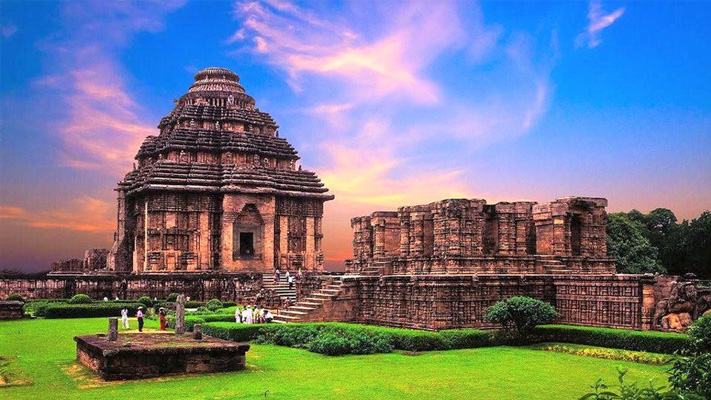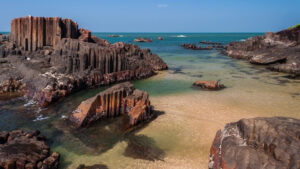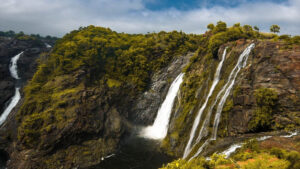KONARK SUN TEMPLE – BASKING IN THE GLORIOUS AURA OF THE SUN GOD

Konark Sun Temple, located in the state of Odisha, India, is a mesmerizing and iconic landmark that attracts tourists from around the world. Here’s an overview of Konark Sun Temple as a tourist destination:

- Architectural Marvel: The Konark Sun Temple is renowned for its exquisite architecture and intricate stone carvings. Built in the 13th century, the temple is dedicated to the Sun God and is designed in the shape of a colossal chariot with 24 intricately carved wheels and horses. The temple’s architecture is a remarkable example of the Kalinga style of architecture and showcases the skilled craftsmanship of the era.
- UNESCO World Heritage Site: Konark Sun Temple has been recognized as a UNESCO World Heritage Site, highlighting its immense historical and cultural significance. The temple’s architectural brilliance, coupled with its rich historical and religious importance, make it a must-visit destination for history and architecture enthusiasts.
- Unique Sundial: One of the most intriguing features of the temple is its sundial, known as the “Surya Kunda.” The precise positioning of the temple and its carvings allows the sun’s rays to create accurate time measurements. The sundial’s functionality and accuracy showcase the advanced scientific knowledge of the time.
- Intricate Stone Carvings: The temple is adorned with intricate stone carvings that depict mythological stories, celestial beings, animals, dancers, and various aspects of daily life. These carvings serve as a visual narrative, providing insights into the cultural, religious, and artistic practices of the era.
- Festivals and Celebrations: Konark Sun Temple hosts several festivals and cultural events that add vibrancy to the tourist experience. The Konark Dance Festival, held annually in December, showcases classical dance performances against the backdrop of the temple, creating a captivating blend of art and heritage.
- Surrounding Beaches: The temple is located in close proximity to Chandrabhaga Beach, a pristine stretch of coastline known for its natural beauty. Visitors can enjoy the serene and picturesque surroundings, indulge in beach activities, and witness breathtaking sunrises and sunsets.
- Cultural and Educational Significance: Konark Sun Temple serves as a cultural and educational hub, offering visitors an opportunity to learn about ancient Indian history, architecture, and religious practices. The temple complex houses a museum that displays sculptures, artifacts, and historical information, further enriching the visitor’s experience.
- Spiritual Significance: The temple’s primary deity, the Sun God, holds significant religious and spiritual importance. Many visitors are drawn to the temple to seek blessings, engage in meditation, or simply appreciate the serene and sacred ambiance of the surroundings.
Inside the Temple
Inside the Konark Sun Temple, visitors can explore the sanctum sanctorum (garbhagriha) and the surrounding areas. Here’s a glimpse of what you can expect inside the temple:

- Sanctum Sanctorum: The sanctum sanctorum is the central and most sacred area of the temple. It houses the main deity, Surya (the Sun God), which is now missing. Visitors can witness the empty sanctum and marvel at the architectural details and carvings that adorn its walls.
- Pillared Halls: The temple complex features several pillared halls, known as mandapas, which were once used for various religious and cultural activities. These halls are intricately carved with scenes from mythology, celestial beings, and other decorative motifs. Visitors can walk through these halls, admiring the remarkable craftsmanship and appreciating the historical significance of the carvings.
- Natya Mandapa: The Natya Mandapa, or the dance hall, is a prominent area within the temple complex. It was used for performances and religious ceremonies, particularly dance rituals dedicated to the Sun God. The Natya Mandapa is adorned with stunning sculptures of dancers, musicians, and other artistic representations, showcasing the importance of performing arts in ancient Indian culture.
- Nata Mandapa: The Nata Mandapa, or the audience hall, is another significant area within the temple. This hall was used for gatherings, discourses, and congregational activities. It features impressive architectural elements, including intricately carved pillars and ceiling panels.
- Sculptures and Carvings: The interior walls of the temple are adorned with a vast array of sculptures and carvings that depict various themes and stories from Hindu mythology. Visitors can observe the detailed carvings of deities, celestial beings, animals, and human figures, all showcasing the artistic excellence of the craftsmen of that era.
- Exhibition and Museum: Within the temple complex, there is a small exhibition and museum that provides additional insights into the temple’s history, architecture, and the significance of the Sun God in Hindu mythology. The museum displays sculptures, artifacts, and informational panels that help visitors deepen their understanding of the temple and its cultural context.
Exploring the interior of the Konark Sun Temple allows visitors to appreciate the architectural splendor, admire the intricate carvings, and experience the spiritual ambiance that has captivated people for centuries. It offers a glimpse into the rich cultural heritage and architectural brilliance of ancient India.
Other Top Attractions Nearby
In addition to the magnificent Konark Sun Temple, there are several other notable attractions to explore in the vicinity. Here are some top attractions near Konark:

- Chandrabhaga Beach: Located close to the Sun Temple, Chandrabhaga Beach is a serene and picturesque stretch of coastline. Visitors can enjoy the golden sands, indulge in beach activities, witness beautiful sunrises and sunsets, and savor the tranquility of the surroundings.
- Puri Jagannath Temple: Approximately 35 kilometers from Konark, the famous Puri Jagannath Temple is a significant Hindu pilgrimage site and one of the Char Dham pilgrimage destinations. Dedicated to Lord Jagannath, the temple attracts devotees from all over the world. The annual Rath Yatra (Chariot Festival) held here is a major event.
- Chilika Lake: Situated about 60 kilometers from Konark, Chilika Lake is the largest coastal lagoon in India and a haven for birdwatchers and nature enthusiasts. It is home to a rich variety of bird species, including migratory birds, and offers boat rides, fishing opportunities, and stunning views of the surrounding landscape.
- Udayagiri and Khandagiri Caves: Located in Bhubaneswar, approximately 70 kilometers from Konark, the Udayagiri and Khandagiri Caves are ancient rock-cut caves of historical and religious significance. These caves were used as dwelling places for Jain ascetics and are adorned with intricate carvings and inscriptions.
- Nandankanan Zoological Park: Situated in Bhubaneswar, about 80 kilometers from Konark, Nandankanan Zoological Park is a popular attraction for wildlife enthusiasts. It is home to a wide variety of animal species, including white tigers, lions, elephants, and various exotic birds. The park also features a botanical garden and a large aquarium.
- Lingaraj Temple: Located in Bhubaneswar, approximately 80 kilometers from Konark, Lingaraj Temple is one of the most famous and revered temples in Odisha. Dedicated to Lord Shiva, the temple is known for its impressive architecture and intricate stone carvings. It is a significant pilgrimage site for Hindus.
- Dhauligiri Shanti Stupa: Situated on the outskirts of Bhubaneswar, about 90 kilometers from Konark, Dhauligiri Shanti Stupa is a Buddhist monument that marks the site where Emperor Ashoka is said to have renounced violence and embraced Buddhism. The stupa offers panoramic views of the surrounding landscape and serves as a symbol of peace and harmony.

Best Time to Visit
The best time to visit Konark, considering the weather, events, and festivals, is during the winter months, from October to February. Here’s why:
- Weather: Konark experiences a tropical climate, with hot and humid summers and pleasant winters. During the winter season, temperatures range from around 15°C to 25°C (59°F to 77°F), providing a comfortable and enjoyable environment for exploring the attractions.
- Festivals and Events: One of the major festivals celebrated in Konark is the Konark Dance Festival, held in December. This festival showcases various classical dance forms against the backdrop of the magnificent Sun Temple, creating a mesmerizing experience for visitors. Attending this festival allows you to witness the cultural vibrancy of the region.
Avoiding Extreme Heat: Summers in Konark, from March to May, can be quite hot and humid, with temperatures often exceeding 40°C (104°F). Exploring the outdoor attractions in such high temperatures can be challenging and uncomfortable. Winter offers a relief from the heat and allows for a more pleasant visit.


















































